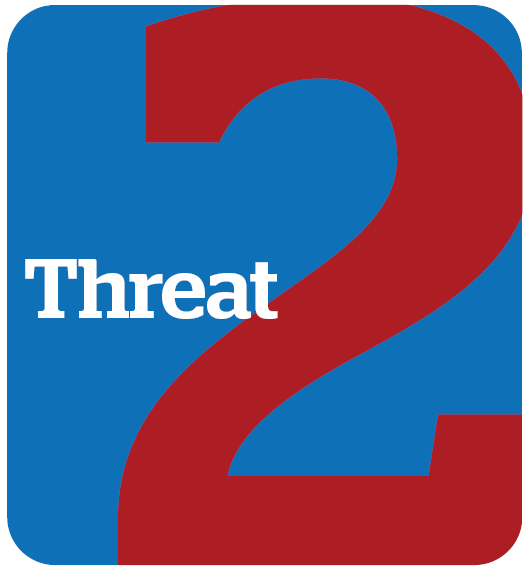3 Mar 2022
Big 6 returns to explore six core dynamics shaping the veterinary profession today and in the future – starting with a discussion on the impact of technology.

 Almost five years ago the Big 6 project broke new ground with a series of hard-hitting articles focused on the six core dynamics shaping the veterinary profession at that time.
Almost five years ago the Big 6 project broke new ground with a series of hard-hitting articles focused on the six core dynamics shaping the veterinary profession at that time.
Now, Big 6 is back, with a series of in-depth features and long-form podcasts to bring Vet Times readers exclusive insights and analysis about the dynamics driving the sector today, and in the future…

Image © Tierney / Adobe Stock
Since the turn of the century, the veterinary profession has been shaped and remodelled by the irresistible impact of many powerful dynamics. Some of these dynamics have brought – and continue to bring – unwanted change and disruption; others have delivered opportunities for innovation and evolution within the sector.
The coronavirus pandemic has accelerated many of these forces of change, with COVID-19 compelling practices and their people to respond in ways that have not only highlighted and exacerbated existing problems, but also pointed towards new possibilities and potentialities.
It is against this backdrop that Vet Times is rebooting the Big 6 project – an expert discussion forum that broke new ground when results were first published five years ago in sister title VBJ.
The premise of the project is to put six core areas of the profession under the spotlight to examine some of the driving forces shaping modern veterinary practice.
Our ambition across this monthly article and podcast series is to not only provide an insight into how things currently stand, but also produce a road map for the future.
To help us achieve that ambitious goal, Vet Times is hosting a series of expert forum discussions featuring vets, business leaders, and key opinion leaders from both inside and outside the sector.
Starting with the subject of transformational technology, the series will go on to cover client care, engaging employees, operational opportunities, and finance and regulation, before finishing with a deep dive into the short and long-term impacts of COVID-19.
For the first article in the series, we invited business consultant Alison Lambert, IT expert Jack Peploe, innovation consultant Greg Dickens, practice owner Jenny Reason, and vet business owners Thom Jenkins and Jamie Crittall to discuss the impact of technology on the profession.
As expected with the enormous scope of this opening topic, discussions touched on many areas, but generally fell under three broad themes: telemedicine and digital connection, practice management systems, and wearables and other advances.
 Thom Jenkins
Thom JenkinsVet and co-founder and chief executive of PetsApp – a mobile-first veterinary telemedicine platform enabling veterinary clinics to offer text chat and video consultations to pet owners. Thom also chairs VetForum, an international series of B2B veterinary sector events, and serves as an advisor to YLD – one of London’s fastest growing software engineering and design consultancies.
 Jenny Reason
Jenny ReasonAn experienced small animal vet and owner of Bury St Edmunds Veterinary Centre. Jenny holds a Certificate in Advanced Veterinary Practice and has a particular interest in surgery and orthopaedics.
 Alison Lambert
Alison LambertManaging director of training, research, marketing and veterinary business consultancy Onswitch. Alison is an also a honorary associate professor of veterinary business at the University of Nottingham and holder of both the Australian Veterinary Association’s Veterinary Business Thought Leader and RCVS Impact awards.
 Jack Peploe
Jack PeploeA serial tech entrepreneur who has been working in the IT sector since setting up his first business aged 16. Jack now runs a technology group, which includes award-winning industry specialist technology services for the veterinary, not-for-profit and recruitment sectors.
 Jamie Crittall
Jamie CrittallCo-founder and senior director of health care compliance technology company Virtual Recall. Jamie is also a vet and the owner of Beech House Vets, a multi-branch independent practice in Surrey.
 Greg Dickens
Greg DickensA veterinary surgeon and innovation consultant with Innovia Technology. Greg has authored numerous articles on the subject of innovation in the veterinary sector.
When COVID-19 first struck in March 2020, the veterinary profession’s response to the crisis was swift and decisive.
Within days, a rapid response to Government guidelines meant an “emergencies only” edict was issued by the BVA calling on practices across the UK to only remain open for emergency care and urgent cases.
All routine and non-urgent in-practice appointments were scrapped overnight – a move that effectively put a giant firewall between millions of pet owners and their veterinary practices.
But, as the old adage goes, “necessity is the mother of invention”, and almost as quickly as the pandemic emerged, practices up and down the country scrambled to find new ways to keep connected with their client bases.
And for many, this meant taking the plunge into the world of telemedicine and virtual consults, which, at least for the first few months of the pandemic, became vital tools for thousands of practices.
But as Alison Lambert, managing director of veterinary business consultancy Onswitch, explained, while this approach worked well enough when the chips were down, it is far from being an optimal long-term solution.
She said: “We were in the middle of a global pandemic and had to do something – we have to remember that for practices who were put into lockdown, shut down, furloughed people, staff didn’t come in, there had to be something else that enabled animal welfare to be delivered in that moment of extremeness, and I do think that the profession responded well. Whether that was FaceTime, phone calls, video platforms – whatever that was.
“Does the client want it now? Most of them don’t. If it is used in isolation of any prior knowledge or any other knowledge, there are limitations. In the human health care system, the NHS is already reporting patient outcomes being compromised where there hasn’t been face-to-face or clinician-patient access.”
Like hundreds of other practice owners, Jenny Reason at the Bury St Edmunds Veterinary Centre in Suffolk turned to various digital means to stay in touch with clients and deliver veterinary care, and continues to do so even with the worst of the pandemic seemingly over.
Jenny said: “Obviously COVID hit March 2020 and we opened May 2019, so technically speaking we have been operating more in a pandemic than we have been out of a pandemic.
“Right at the start of the pandemic we did do some video consultations and things like that, but I have got to be honest, they were not fun for anyone involved. You’re just relying on owners holding their phone in the right position, using the right position, using the right camera, etc.
“But I think these systems are useful going forward for when you are doing stuff for the owner rather than necessarily for the pet, so discharge, or when they are wanting to send static photos for post-op checks and bits like that, that’s when they can be really useful.
“You can have your initial stuff in the clinic, and then your follow-ups can be a lot more remote. So you don’t have to have them coming in so much for post-op checks – especially simple things like cat spays and things like that; you don’t have to have them coming in for those.
“It is just finding a way that it works for the individual practice and the practice’s clients.”
Jamie Crittall, co-founder of health care compliance technology company Virtual Recall and practice owner, added: “We just haven’t had the opportunity to really look back, assess and take the good bits, the bad bits or whatever, but since March 26 2020, I haven’t stepped foot in my practice and I hear that they are stacked.
“They’re crazy busy – does that make it effective and profitable work? Well, the jury is definitely out on that.
“Communication, I think, has been the most vital element in all of this. In every walk of life. And if you have been able to communicate clearly; in a timely way; in a personal way to your clients, they appreciate it.
“Going forwards, we need to be able to find that happy medium – the new normality in which we can end up working collaboratively with our clients, to gain a better outcome.”
For Greg Dickens, veterinary surgeon and innovation consultant, finding the right tools to facilitate effective communication is the key, now and in the future.
“Communication is the most vital element here”, he said. “What everybody has been talking about when they talk about telemedicine is telecommunication, and everyone has given some version of how getting information from clients and animals is a nightmare.
“We are effectively regulated on our ability to get information out of our patients. That is a clinical skill, but expecting untrained clients to do that makes no sense. Logically, that is not an easy leap. Whereas none of us are taught how to ring up a client and tell them things. That is not a clinical skill; that is not something you have to pass exams to do.
“What I am seeing is tools that aren’t built for getting information out of animals, such as a smart phone camera that are rubbish at it, and that makes sense.
“If we were to combine wearable tech – which is basically client-facing diagnostic tech – with telemedicine, we are likely to have better luck.
“And the tie-in of that tech is likely to happen more and more over the next five years. I believe it will get better, yes I believe it will be more important and, hopefully, the burning pains of telemedicine where nobody could get any good information out of their patients will finish. Or am I being overly optimistic?”
Thom Jenkins struck a more cautious tone and warned that any future developments in this area need to take place in a way that has the needs of a highly stressed workforce at its core.
He said: “In terms of telemedicine, where people are thinking ‘video consults’, we did see an early peak in those at the start [of the pandemic] as people were looking at revenue replacement opportunities, and we have seen some clinics continue to use those very, very well.
“Since then there has been a drop-off in video consults, with a massive uptick in text chat and file sharing collaboration. So this is not about digitally replacing clinics, it is about digitally augmenting them.
“But I think that people aren’t looking for futurism right now. I think they are looking for pragmatism. No one is looking for one more thing for the sake of having one more thing to do.
“We need to be careful because any new technology is going to be looked through that lens, maybe slightly cynically – ‘Is this one more reason I am not going to get my lunch break?’; ‘Is this one more reason I am not going to get home on time?’.
“So I think any innovation, especially right now, needs to have extreme empathy with the position that veterinary teams are in, and I think it is very hard to get people excited when people say ‘look what more you could do for your patients; look what more you could do for your customers’.
“I think we must focus on need fulfilment for veterinary teams, so giving them the right tools to feel like they are not having to sacrifice more than they can to be in this profession and service the needs they are already being confronted with, I think, is the immediate future at least.”
For non-vet Jack Peploe, the way the profession responded and adapted to new technologies in the wake of COVID was impressive, but he clearly feels time now needs to be taken to reflect on what worked and what didn’t.
He said: “The creativity of the profession is amazing – at the start of the pandemic the stuff these vets did was just incredible.
“It was really good to see, but in some cases it was ‘How am I going to get myself out of this predicament right now?’ and it wasn’t really a thought about what is the right solution and what am I trying to solve, and so you saw a rush of integrations of solutions.
“Thankfully, you have got very intuitive platforms like PetsApp that have very much helped the situation, but for many it was very much a rushed decision and I don’t think sometimes that a lot of practices have had the chance to sit back and look and decide how can they make this better?’.
“If things are planned and structured in the right way, and done properly, it can be done really, really well.”
“I think we need to catch up because the future is already here – we just haven’t quite caught up with our clients yet.”
Alison Lambert
Image © Syda Productions / Adobe Stock
While the pandemic has undoubtably accelerated the rate at which many practices have had to adopt digital communications and telemedicine – to one degree or another – adjusting to new technologies has always been a part of practice life.
Roughly 20 years ago, most practices began to make the seismic shift from paper and card records to a computerised practice management system (PMS) – systems that now dominate large areas of veterinary life.
And while there can be little argument that the PMS has delivered great efficiencies when it comes to how practices are run, our panel questioned whether some of these systems remain fit for purpose in the modern world.
Jack said: “I think one of the biggest issues against the PMS is the constraints and control that the PMS provider has over the veterinary practice. Because, ultimately, when you think of veterinary-based technology, you think of the PMS – it is the lifeblood of the business.
“In some ways it is the reason why there has been limited progression and the veterinary industry has been constrained so much, because these practice management systems and solutions haven’t developed.
“Another big thing here is around data. Practices have a lot of data within the PMS, and it’s almost controlled and governed by the PMS vendor, but ultimately that data belongs to the client.”
Developing this point, Thom added: “Practices are exploiting their position as a data silo, but it is not their data. So what are we doing charging people for access to it? Or gatekeeping it – that can be a source of frustration.
“I have great respect for my colleagues that are building practice management systems, but the difficulty there is the surface area of the product you have to maintain – you have got the medical record, the business intelligence, invoicing, appointment scheduling, rotas, all this stuff.
“So the idea that they [the PMS providers] are then also going to build a client communication platform, an app, web widget or web portal to meet the evolving needs of both the team, and the pet owner and the pets, I have some scepticism.
“One thing I do see emerging is small door, tech–enabled veterinary clinics who have their own individual apps – either white-label products or co-branded as an increasing number of clients want to engage with their veterinary practice in that way.”
According to Alison Lambert, in five years’ time practice management systems as they are now will be a thing of the past.
She said: “I think we are trying to get a better horse when the combustion engine has been invented. When we look at five years from now, the only thing that really matters is the custodian of that data.
“That data is our patient’s data and it needs to be transferable between places that need it, so at the emergency clinic, day clinic, vaccine clinic, the specialists, where the insurance claim comes from, where the lab results come from. There has got to be a common ground, and that common ground is currently being used – the microchip.
“So VetDB in Australia are using it; each patient ID, time and date, code stamped, lab reports, insurance claims, vaccine status, the whole shaboodle is scanned in and sorted. So wherever that patient goes, it’s record goes with it – you just have to scan the chip and go to the magic cloud.
“We are currently putting the data in a box in the building when the pet moves. And for me, we are constraining our imagination by what is rather than going what could it be.”
For Jamie, the future challenge is trying to create an ecosystem that is open enough for data to be shared so seamlessly.
He said: “Systems like PetsApp, iRecall and VetDB being able to securely link information to health providers for referrals is great, as long as there is a seamless flow of data information, but it takes time and, ultimately, it probably does come down to data control, the data processor and who is the gatekeeper.
“And at the moment, perhaps the practice management software providers feel they are in charge of that, and then even us as vet practice owners, we are also then very conscious that we want to protect our client data.
“But ultimately, I think that everything should come together to improve the outcomes of the pet and their health.”
Closing this section of the debate, Greg urged caution.
“The only thing I can add to this debate is be careful, because the practice management software market in hospitals, in the US certainly, is being eyed very greedily by the hardware manufacturers who want to take over the practice management software,” he said.
“They certainly want to take the hospital management software because they have the kit in the room and they can be cagey with who gets the data. So just watch out – there are other competitors on the way.”
While the panel talked at length about possible developments in the way practice data is stored and used, Jenny pointed out that functionality is already contained in existing practice management systems that can be harnessed to have a powerful impact.
She said: “I think PMS software has to enable the team in the practice to provide the level of care that they want to be able to provide for that pet and for the owner, but it also has to champion those people in the practice as well and make their lives easier, and I think the veterinary profession as a whole obviously has a massive issue at the moment with retention and things like that, and people feeling like the public are against us, which is just actually not really the case.
“One of the things that I actually do like about our system is that it provides real-time feedback so every time a consultation is completed it shows that 99.99% of people are super happy at the end of the day and they all write lovely things, and that comes straight back to the team.
“The team can see all of it and they can see that, actually, a vast majority of people absolutely love what they do. I think that if more of the profession could see actually how good a job they do then they would stay and they would enjoy their jobs more.”
“I see the future as really, really bright. With the right organisations producing amazing products, services, drugs, animals are going to be in a good place in the future.”
Jamie Crittall
Image © photodigitaal.nl / Adobe Stock
In recent decades there has been an increased focus placed on preventive health care across both the human and the animal health sectors.
This approach takes many forms, but one aspect is the collecting of health and movement data directly from animals using wearable technologies capable of automatically gathering and storing that information.
For some years such technologies have been in widespread use within the farming sector to monitor herd and flock health, and our panel discussed the significance of their increased use to protect the health of the UK’s pets, too.
Alison believes the companion animal sector can learn a great deal from the way these technologies are used with production animals.
She said: “If we extend this beyond pet and look at farm production, and the role of data; big data – at herd level – and the way the farm production guys have managed optimising health outcomes, there is a different priority and there is a different revenue channel associated with getting that better.
“So I think the farm guys can teach the small animal guys quite a lot about the bigger picture as they are ahead of us in the companion animal sector.
“This is all about portability; movement; dynamic populations. People move houses and homes, and clinics, but one of the constancies is the need to know what’s wrong with a dog when it’s hit by a truck, for example. The means to get this data has got to be attached to the dog somehow and that’s not wearable tech, that’s embedded tech.”
Greg added: “I think a lot of what we call in the profession wearable tech, we should be talking about client-facing tech. It doesn’t matter where it is in the home or the farm, or wherever. It’s not about wearability, it is about client-facing tech use – normally for gathering data; sometimes for delivering treatment. It should be an extension of the practice, in the home.
“In my house I have a Wi-Fi router, a smart doorbell and a security camera that can see in infrared – it would not take much software, maybe a little firmware, to allow that Wi-Fi monitor to tell me how often the cat walks around the house just by the change in reflections, for the smart doorbell to give me a quick look at the gate when it does so and for the security camera to give me a rough look at its temperature.
“All you then have to do is link that to a way to monetise – even if it is only a tiny amount of money – the ability to say ‘your pet needs to be seen, please bring it in’.”
Jack made the point that a general lack of education in the veterinary sector about the capabilities of technologies (both old and new) can often slow the rate of development, and prevent practices making the most of the opportunities.
He said: “I think this all comes back to the point that it is the lack of education, training and enablement of all these platforms.
“If we take most practices within the country, they’re going to struggle to do these things, and that is why they need to have partners to work with them and digitally enable them with their technologies, and allow them to get the most from their platforms.
“For example, I think 80 per cent of practice management systems within the UK are server-based, which is mental in my eyes; that is bonkers, but it is because no one is having a chance to be able to review these things.
“It comes down to all these types of technologies – no one is going to see the benefit if no one comes out and actually tries to educate them and, again, enable the profession; that’s what it comes down to in my opinion.”
There are, of course, technologies that are still some way off, such as robotic surgical solutions and systems that will use big data to completely transform the way vets work, and according to Greg, while nobody should expect to see robots performing surgery on animals any time soon, change is coming and the veterinary profession must be ready.
He said: “I have been working on robot surgeons for five years and it is way outside five years for veterinary. For a medical robot surgeon it is very easy comparatively because the surgery to be done is identical. The patients are nearly identical and it has always got somebody – a best in the world person – looking over its shoulder.
“For a veterinary surgical robot to do the same thing, it has to be able to do that for a massively different range of patients. The surgery is always slightly different and the system is no where near good enough yet, but it will come – just not within a five-year time frame.
“As for what your consult looks like; we talked about the various sources of data either making it easier for clients to give us data or making it easier for us to take data remotely from place to place, or making it easier for us to gather data without the client even noticing we are gathering data from around where the pet lives.
“All of that comes together in a perfect future consult where you are offered options – there is all sorts of diagnostic support and differential diagnosis offered to you that you can then select from, and you don’t have to work out doses of things if you say you want a particular drug; the dose is automatic.
“Hopefully you can turn the three or four minutes of hardcore thinking time in a consult into a three or four-minute consult where it is all hardcore thinking time and there is none of that wastage.
“Whether people can handle that without burnout, I don’t know, so hopefully future consults come along with better care for workers built in, too.”
“There’s a great opportunity for somebody here to look after the nation’s pets really well. I think the threat is that it is not going to be the vet industry as it stands at the moment.”
Greg Dickens
By way of a conclusion to this first article, we asked all our panellists to provide us with a threat and opportunity rating for the subject of transformation technology. We’ve taken all our panellists’ responses to produce an overall rating…


Do you agree with our panellists’ scores? Answer our quick poll below: